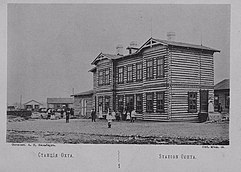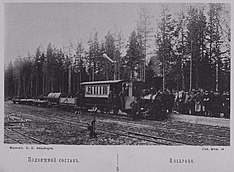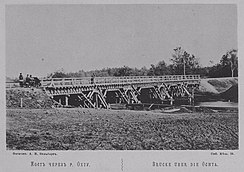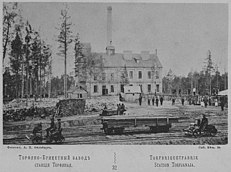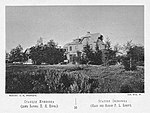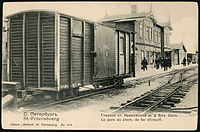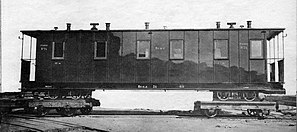Irinovka Railway
| Irinovka Railway (narrow-gauge railway) around 1912 | |||||||||||||||||||||||||||||||||||||||||||||||||||||||||||||||||||||||||||||||||||||||||||||||||||||||||||||||||||||||||||||||||
|---|---|---|---|---|---|---|---|---|---|---|---|---|---|---|---|---|---|---|---|---|---|---|---|---|---|---|---|---|---|---|---|---|---|---|---|---|---|---|---|---|---|---|---|---|---|---|---|---|---|---|---|---|---|---|---|---|---|---|---|---|---|---|---|---|---|---|---|---|---|---|---|---|---|---|---|---|---|---|---|---|---|---|---|---|---|---|---|---|---|---|---|---|---|---|---|---|---|---|---|---|---|---|---|---|---|---|---|---|---|---|---|---|---|---|---|---|---|---|---|---|---|---|---|---|---|---|---|---|---|
|
Construction of the Ochta station on the Irinovka Railway, around 1892
Mixed train in an Arthur Koppel catalogue, c.1892 | |||||||||||||||||||||||||||||||||||||||||||||||||||||||||||||||||||||||||||||||||||||||||||||||||||||||||||||||||||||||||||||||||
|
Course of the route around 1912
| |||||||||||||||||||||||||||||||||||||||||||||||||||||||||||||||||||||||||||||||||||||||||||||||||||||||||||||||||||||||||||||||||
| track length: | 35.75km | ||||||||||||||||||||||||||||||||||||||||||||||||||||||||||||||||||||||||||||||||||||||||||||||||||||||||||||||||||||||||||||||||
| gauge : | 750 mm ( narrow gauge ) | ||||||||||||||||||||||||||||||||||||||||||||||||||||||||||||||||||||||||||||||||||||||||||||||||||||||||||||||||||||||||||||||||
| Maximum incline : | 20 ‰ | ||||||||||||||||||||||||||||||||||||||||||||||||||||||||||||||||||||||||||||||||||||||||||||||||||||||||||||||||||||||||||||||||
| Minimum radius : | 45 m | ||||||||||||||||||||||||||||||||||||||||||||||||||||||||||||||||||||||||||||||||||||||||||||||||||||||||||||||||||||||||||||||||
|
|||||||||||||||||||||||||||||||||||||||||||||||||||||||||||||||||||||||||||||||||||||||||||||||||||||||||||||||||||||||||||||||||
The Irinovka Railway was an initially almost 36 km long, private narrow- gauge railway with a gauge of 750 mm, which was operated from 1892 to 1923 on the outskirts of St. Petersburg .
story
planning and construction

• Length of the railway: 33½ versts (35¾ km)
• Gauge: 0.75 m
• Smallest radius: 25 fathoms (45 m)
• Maximum gradient: 1 ⁄ 50 = 2%
• Stations and stops: 16
• Bridges: 8
• Spans: 24, 18, 12½, 10, 7½, 5, 2 and 2 fathoms
• Spans: 43.2; 32.4; 22.5; 18; 13.5; 9; 3.6 and 3.6m
The first public narrow-gauge railway in Russia was built in 1871 in the Oryol Governorate . Narrow-gauge railways followed in Kursk , Novgorod and Arkhangelsk provinces . The construction of the narrow-gauge railway to Irinovka began in June 1891 on the initiative of Baron Pavel Leopoldowitsch Korff (1836-1913), whose estate was near the village of Irinovka in the Schluesselburg district . It operated between the Okhta works and the polygonal Rzhevsky fortress under construction; up to 80% of passenger and freight traffic should be handled on it. An extension of the line to Irinowka made it easier to develop production on Baron Korff's estate and to build holiday villages on the lands of the other narrow-gauge railway shareholders. p. 192 f
Arthur Koppel , a German engineer and specialist in the manufacture of equipment for narrow-gauge railways, made a cost estimate for the line in August 1888, which called for a gauge of 750 mm. The economic feasibility study was prepared by St. Petersburg merchant Fyodor Andreyevich Gokh , according to whose calculations the first section of the railway should cost 210,000 rubles. p. 194 Overall management of the construction was in the hands of Konstantin Bezpalov , a state councilor and railway engineer. The head of the Irinovka railway was the privy councilor and railway engineer Alexey Alexandrovich Ekarev , who was in charge of building the Porokhavaya railway station. p. 419 In 1890, the industrial company Irinowka-Schlussenburg was founded for this purpose, the shareholders of which were initially Baron P. L. Korff, Baron M. N. Medem, Egor Abramowitsch Peretz, V. A. Rennenkampf and Pavel Alexandrowitsch Vsewoloschskij . p. 196 Thanks to Elena Vasilyevna Vsevolozhskaya, the wife of Pavel Aleksandrovich Vsevolozhsky, the owner of the Ryabovo estate, the route did not follow the shorter stretch along the right bank of the Lyubya River, but made a curve through the middle of their property around the Rumbolovsky -Kyazelevskaya Hill, which gave impetus to the construction of dachas and country houses on their plot. p. 194
The route was built according to the American model, with simplified requirements for the superstructure , the terrain profile and the route plan as well as the technical facilities. Construction of the line began in June 1891. It was 35.25 km (33.5 versts) instead of 32 km (30 versts), about 11% longer than originally planned because some landowners forbade Baron Korff to use the narrow-gauge railway on their land to be laid, while others only allowed construction on the route they desired, resulting in many additional arches and a significant deterioration in their terrain profile. Lacking the right to expropriate private land, Baron Korff asked the relevant institutions to be able to serve the state powder plants and both landfills, as well as use two sections of the broad gauge rail network, namely a 275 m (150 fathoms) section of a Crane on the Okhta River to the third kilometer (third verst) of the Irinovka Railway and an 825 m (450 fathoms) section between Rzhevka station (Ржевка) and Voennaya station (Военная). A third rail for a three-rail track was laid on these sections of the state broad-gauge railway. The different trains ran on it according to a special timetable that was determined by mutual agreement between the interested parties. The operation of the Irinovka Railway came under the commander of the St. Petersburg branch of the Nikolai Railway and was overseen by the Vyborg Department of the Finnish State Railways .
opening and operation
The official opening took place on September 14, 1892. Regular traffic began on October 1, 1892. The route began at the Okhta railway station, which was located on Bolshaya Okhta, at the crossroads of Polevaya and Panfilova Streets, on the site of today's house No. 36 on Metalistov Avenue. In 1895, the Irinovka narrow-gauge railway was extended by 710 meters to the pier on the Neva, where in 1898 at 1 Panfilova Street (near the current house number 62 on the Sverdlovskaya Embankment) the new Okhta-Neva freight and passenger station was built would.
In 1895, the Vsevolozhskaya station was opened between Ryabovo station and Christinovka station. In 1896, the railway line from Irinovka to Borisova Griva station was extended through the efforts of the Irinovsko-Schlisselburgskiy industrial company, a branch line Shernovka - Okhta Powder Plant, and a new branch line from Melnichny Ruchey station to Sheremetevka station on the Neva river bank southwest of the village of Sheremetvka and the Pulverwerks Schlüsselburg built.
The number of stops, the pairs of trains and the rolling stock of the new route were constantly being changed. In 1897 there were 18 stops on the first section, in 1911 there were 22. The branch line had 7 stops.
Buildings along the Irinovka Railway
At the Okhta station on Panfilovskaya Street in St. Petersburg, there was a two-story log house, a one-story railway administration building, two waiting rooms and an engine shed with repair shops.
Three years after the opening of the narrow-gauge railway, it was recognized that St. Petersburg needed a transhipment facility onto river boats on the Neva . Therefore, the route was extended to the banks of the Neva, and in May 1895 the Okhta-Neva railway station was opened on Panfilovskaya Street at Sverdlovskaya Embankment 62. There was a jetty and a fuel depot. For safety reasons, the connection between the station and the station of Ochta was initially only established at night with horse-drawn trains. From 1897, trains ran regularly to the terminus.
The Irinovskaya railway crossed a Navy Ministry broad-gauge railway used to deliver shells for the Artillery Proving Grounds. Voennaya military station was built here. Part of the line was used as a three-rail track, so that the narrow-gauge railway could be used to transport goods to and from the Ochta gunpowder factory.
The station Christinowka was located on the land of the confectioner and merchant Johann Bernhard, who had immigrated from Switzerland. Since the train station of the same name Christinovka already existed in southern Russia , mail and parcels intended for Bernhard were occasionally accidentally delivered there. Therefore, Johann Bernhard submitted an application to renaming the station Christinowka in Bernhardowka. His request was granted, and in January 1910 the station was officially named Berngardowka.
In 1895 the Vsevolozhskaya railway station was opened at the Vsevolozhsky Prospect level crossing over the narrow-gauge railway. It had two-story wooden buildings and a one-story building for workers and inventory storage. A year after opening, the building burned down and was rebuilt on the opposite side of the railway line.
In 1872 PA Vsevolozhsky opened a sawmill and a steam mill on the Ryabovo estate.
Baron P.L. Korff ran a peat cutting and a factory for the production of peat briquettes, which were then used as fuel, near the village of Irinovka. Since the late 1930s, peat was mined by the Irinovsky peat company (Ириновское торфопредприятие), which operated an extensive narrow-gauge railway network between the broad-gauge stations of Rakhya and Borisova Griwa. During World War II it was one of the few peat farms near Leningrad that was not on the occupied territory, which was crucial during the siege.
In the 1960s, the steam locomotives on the narrow-gauge railway were replaced by the diesel locomotives of the SŽD series ТУ4 , СЭП2 and СЭП2М, and later by the diesel locomotives ЭСУ1, ЭСУ2А, ТУ6А -070 and by the railcars АМ-1 . The main locomotive depot was in Rakhya. The depot had a roundhouse with a turntable, which was very unusual for peat narrow-gauge railways. The peat narrow-gauge railway ceased operations at the end of 1996. The last section of the peat narrow-gauge railway was dismantled in 1998.
There was a private gunpowder factory in Schluesselburg.
rail vehicles
locomotives
Before the October Revolution , only two- and three-axle tank locomotives of type B and C were used on the Irinovka Railway . All locomotives ran on coal, although peat was plentiful in the area. In 1896 the powder works required that steam locomotives be fitted with spark arrestors. Since the early 1920s there have also been four-axle locomotives from local production.
The first five steam locomotives, delivered by the German company Arthur Koppel, Berlin in 1891–1892, were two-axle and had an output of 20 to 40 hp. In operational condition, they weighed between 5 and 7.5 tons. The smallest locomotive could pull a train up to 100 tons, the largest up to 240 tons. The trains ran at speeds of up to 20 km/h. This was not only related to the performance of the steam locomotives, but also to the fact that there were multiple derailments in the initial phase of using the narrow-gauge railway.
The steam locomotives of the Irinovka Railway were named not only by numbers, but also by Baron Korff and his relatives. These names were retained until 1900, after which the locomotives were only given numbers. The Arthur Koppel company, which was the first to export 750 mm gauge locomotives to Russia, supplied steam locomotives from other manufacturers in Europe and North America at the time, as they were not yet building their own locomotives at that time.
| No. | Name (German) |
name (russian) |
Construction year | Manufacturer | Cylinder diameter × stroke |
wheel diameter | steering | boiler pressure | power | price |
|---|---|---|---|---|---|---|---|---|---|---|
| 1 | Julia | «Юлия» | 1891 | porter | 179 × 304mm | 620mm | Stephenson | 1071kg | 40 hp | 8500 rubles |
| 2 |
 Maria |
«Mariya» | 1891 | Jung factory no. 121/1891 delivered 12 Oct 1891 (or Krauss ) | 165×330mm | 600mm | Stephenson | 857kg | 30 hp | 7000 rubles |
| 3 |
 alexandra |
«Aleksandra» | 1891 | Jung factory no. 122/1891, delivered Oct. 16, 1891 to Arthur Koppel | 150×250mm | 600mm | heusinger | 714kg | 20 hp | 6000 rubles |
| 4 |
 Sergei |
«Sergey» | 1891 | porter | 179 × 304mm | 620mm | Stephenson | 1071kg | 40 hp | 8500 rubles |
| 5 | Pavel | «Pavel» | 1893 | Krauss factory no. 2376/1891 | 180×300mm | 620mm | Stephenson | 1071kg | 40 hp | 8500 rubles |
| 6 |
 N.6 |
H.6 | 1895 | OK | 200×300mm | 600mm | Stephenson | 1143kg | 45 hp | 8500 rubles |
| 7 | N.7 | H.7 | 1895 | OK | 200×300mm | 600mm | Stephenson | 1143kg | 45 hp | 8500 rubles |
| 8th | L.8 | L.8 | 1897 | porter | 254×356mm | 710mm | Stephenson | 1714kg | 70 hp | 10500 rubles |
| 9 | I.9 | I.10 | 1898 | porter | 225×356mm | 680mm | Stephenson | 1575kg | 60 hp | 10000 rubles |
| 10 | I.10 | I.10 | 1898 | porter | 225×356mm | 680mm | Stephenson | 1575kg | 60 hp | 10000 rubles |
| 11 | M.11 | M.11 | 1896 | OK | 200×300mm | 600mm | Stephenson | 1671kg | 60 hp | 9500 rubles |
| 12 | H.12 | H.12 | 1896 | OK | 200×300mm | 600mm | Stephenson | 1143kg | 45 hp | 8500 rubles |
| 13 | L.13 | L.13 | 1899 | porter | 254×356mm | 710mm | Stephenson | 1714kg | 70 hp | 10500 |
| 14 | L.14 | L.14 | 1899 | porter | 254×356mm | 710mm | Stephenson | 1714kg | 70 hp | 10500 |
| 15 | L.15 | L.15 | 1899 | porter | 254×356mm | 710mm | Stephenson | 1714kg | 70 hp | 10500 |
| 16 |
 К.16 |
К.16 | 1901 | Kolomensky Zavod No. 2964 | ||||||
| 20 |
 R.20 |
P.20 | 1911 | Kolomensky Zavod No. 4130 |
car
In the beginning there were numerous handcars and probably the following wagons:
- 7 Class II and III passenger cars
- 8 boxcars
- 30 gondolas
- Bogie freight car
The passenger cars of the Irinowkabahn were assigned to classes II, III and IV. The 2nd class carriages were equipped with sofas upholstered in dark red plush, the 3rd class carriages Class with lacquered wooden seats. Class IV wagons resembled freight wagons, in which the farmers sat on wooden benches. In 1900, bogie passenger coaches were purchased from the Kolomnaer Maschinenfabrik-Gesellschaft , formerly the Struwe brothers .
gauge change
| Irinovka Railway (broad gauge railway) from 1923 | |||||||||||||||||||||||||||||||||||||||||||||||||||||||||||||||||||||||||||||||||||||||||||||||||||||||||||||||||||||||||||||||||||||||||||||||||||||||||||||
|---|---|---|---|---|---|---|---|---|---|---|---|---|---|---|---|---|---|---|---|---|---|---|---|---|---|---|---|---|---|---|---|---|---|---|---|---|---|---|---|---|---|---|---|---|---|---|---|---|---|---|---|---|---|---|---|---|---|---|---|---|---|---|---|---|---|---|---|---|---|---|---|---|---|---|---|---|---|---|---|---|---|---|---|---|---|---|---|---|---|---|---|---|---|---|---|---|---|---|---|---|---|---|---|---|---|---|---|---|---|---|---|---|---|---|---|---|---|---|---|---|---|---|---|---|---|---|---|---|---|---|---|---|---|---|---|---|---|---|---|---|---|---|---|---|---|---|---|---|---|---|---|---|---|---|---|---|---|
|
Route of the modern Irinowkabahn (green), today
's Irinowka-Allee (red) and the old Irinowkabahn (blue) | |||||||||||||||||||||||||||||||||||||||||||||||||||||||||||||||||||||||||||||||||||||||||||||||||||||||||||||||||||||||||||||||||||||||||||||||||||||||||||||
| gauge : | 1524 mm ( Russian gauge ) | ||||||||||||||||||||||||||||||||||||||||||||||||||||||||||||||||||||||||||||||||||||||||||||||||||||||||||||||||||||||||||||||||||||||||||||||||||||||||||||
|
|||||||||||||||||||||||||||||||||||||||||||||||||||||||||||||||||||||||||||||||||||||||||||||||||||||||||||||||||||||||||||||||||||||||||||||||||||||||||||||
In 1920, the Construction Department was established to convert the Irinovskaya Railway into a broad gauge line . This was due to the fact that industrial peat extraction began on the former lands of Baron Korff to supply fuel for the Utkina Zavod thermal power plant under construction. The construction of a new broad-gauge line was started from the provisional marshalling post at Sheslovaya on the Obukhovsko-Sanewskaya siding, which is located south of Rzhevka station. Through the former lands of the Vsevolozhsky landowners, the new route ran exactly where Baron Korff had planned it – on the right bank of the Lubya River.
On October 7, 1923, broad-gauge traffic was opened from the Finnish railway station in Leningrad to Borisovaya Griva railway station. In the early years, the route ran through a roundabout with a stop at Dacha Dolgorukova station. In 1925 the track from Melnichny Ruchiei station to Dunai station was changed to broad gauge . In 1926, the new railway line from Borisovaya Griva was extended by nine kilometers to the Ladozhskoye Ozero railway station. The Okhta railway station and its tracks were dismantled, and a tram line was established in their place, along which Irinovsky Prospekt was built.
In autumn 1927 a branch line was built from Dunai station to Sheremetevka station and on to Dubrovka. In late 1928, a five-kilometer single-track crossing from Piskarevka to Rzhevka station with a wooden bridge over the Okhta and a short double-track crossing to the Kovalevo line were built, eliminating the need to get to Dolgorukova dacha. The route was straightened, shortened by 16 km or 40 minutes driving time and given a modern look.
During World War II , the Irinovka Railway played an important role in supporting the life of the besieged city of Leningrad. By land, the Road of Life ran from Leningrad (Finland Railway Station) to the shore of Lake Ladoga . In the 1960s, the tram was electrified. Today, the urban part of the former street is lined with Irinovsky Prospect. In the 1970s, however, Irinovka Avenue was straightened, so that the historical route of the former Irinovka Railway is only preserved in the form of tram tracks along the Ryabovsky highway.
web links
itemizations
- ↑ a b c d e f g h i Ириновская железная дорога. Including route map from 1912. See also route on a topographical map from 1912
- ↑ Ириновско - шлиссельбургская узко-колейная гкел. Dor. Course book excerpt 1914/15.
- ↑ Route diagram In: Леонид Москалев: Ириновский подъездной путь. Moskva Иэдотельпв «Железнодорожное Дело», 2000.
- ↑ AI Wilborg (А. И. Вильборгь): Irinovka narrow-gauge railway. Bilingual photo album (Russian and German). Printing house Yu. Volner & Co, 1892 ( Ириновская железная Дорога, Альбом фотографий. Iovр. Цева. Спб., 9-ro сеитпбря: Типография ю. Вольнер и к °, 1892 г.)
- ↑ a b c d Ferman В. B. Всеволожск: историко-географический справочник. Chest 1 (1500—1917). — СПб.: «Гйоль»; «Ostrov», 2019. — 480 c. — ISBN 978-5-904790-84-4 . pp. 192-194 and 196-198.
- ↑ Ferman В. B. Всеволожск: историко-географический справочник. Chest 2 (1917—1941). — СПб.: «Гйоль»; «Ostrov», 2020. — 512 c. — ISBN 978-5-904791-04-9 . pp. 225–229 and 419.
- ↑ Нива. № 42. 1892 year. p. 924
- ↑ a b Ириновский Подъездной Путь (Irinovsky feeder line).
- ↑ Фролов А. I. (Frolov AI): Санкт-Петербург от А до Я. Вокзалы. Издательство "Glagol", 2008.
- ↑ Ириновский вокзал на плане Санкт-Петербурга издания Щепанского. 1894 god.
- ↑ Ириновский вокзал на карте района маневров. 1913 god.
- ↑ Леонид Москалев: Ириновский подъездной путь. Москва Иэдотельпв «Железнодорожное Дело», 2000. P. 22 , p. 23 and p.25
- ↑ Иржи Индра (Jiří Indra): Исторический очерк развития Ириновской железной дороги. (Historical Sketch of the Development of the Irinovka Railway), Aug. 15, 2020
Coordinates: 60° 1′ 8″ N , 30° 40′ 45.9″ E




